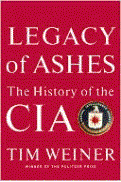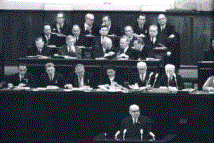Why It Could Have Done Better in the Cold War
by Haviland Smith
A retired CIA station chief and Soviet specialist examines the Agency’s heritage from the OSS of World War II and finds that it produced a bias toward covert action to the detriment of intelligence gathering. As CIA evolved and gained experience, its intelligence capabilities improved, but it had little success in divining Soviet intentions during the Cold War. The Politburo was a tough target; so are today’s Middle East terrorist groups. – Ed.
Prior to World War II, the United States had no centralized intelligence collection, analysis and production structure. The State Department was involved in the overt and some minor ad hoc covert collection of intelligence. The FBI was active collecting information in Latin America in what were essentially criminal law enforcement activities. The military had its tactical military collection imperatives, and there was a small unit, the Signals Intelligence Service of the U.S. Army, collecting signals intelligence. All of these activities were minor, unconnected, and uncoordinated.

During the Second World War, the requirements for intelligence and intelligence-related activity rose sharply. This hot war on foreign soil brought with it U.S. support of anti-Nazi and anti-Japanese guerrilla operations in Europe and East Asia. The Office of Strategic Services (OSS) was formed in 1942 to deal with those realities and soon went into business full bore, conducting resistance operations, which were essentially covert action (CA) operations that were not assigned to other agencies.
Numerous guerrilla groups had sprung up spontaneously in occupied Europe, China, and French Indochina. In Europe, France, Holland, Belgium, and the occupied Scandinavian countries all had their movements. The British, who had long had their own intelligence organizations, were in touch with many of those resistance movements. They were also very much involved in getting the OSS off the ground and properly trained. Ultimately, OSS established contact with a number of resistance groups, and as the war progressed toward the Allied invasion of Europe, the OSS got more involved in coordinating and leading some of those groups in demolition operations and in harassing German occupation troops. The late CIA Director William Colby parachuted into both France and Norway to lead resistance activities against the Germans.

That was the primary OSS activity — contacting, supporting, and leading these resistance groups by parachuting personnel into occupied Europe. In effect, the birth of OSS was a hot war reality that demanded extraordinary heroism from its personnel. It also signaled the onset of CA operations, including resistance operations, on behalf of the U.S. government. It was a really high-risk business that attracted heroic and adventurous people who did their jobs well.
OSS was disbanded at the end of the war in l945. The State Department took over the research and analysis function. To preserve OSS’ clandestine intelligence capability, the War Department took over secret foreign intelligence (FI) and counter-espionage (CE) activities under the aegis of the newly formed Strategic Services Unit. This unit was then transferred to the Central Intelligence Group in 1946 and became the Office of Special Operations (OSO) when the CIA was created under the National Security Act of 1947. In 1948, the Office of Policy Coordination (OPC) was created to oversee all psychological and covert action (CA) operations. It was absorbed in 1952 into OSO. Thus, the hot war covert action capability of the OSS, most emphatically including many of its personnel, was preserved in the new CIA.
CIA was created at the beginning of the Cold War in response to the ongoing Soviet geographic expansion into Eastern Europe as well as Soviet attempts to expand into Western Europe. CIA’s job was to stop Soviet expansion and, in the minds of the wishful thinkers of the time, to bring down the USSR.
Under these conditions, it was predictable that the CIA would go back to its roots, back to the activities it had known and successfully carried out during the war. It got heavily into émigré operations in East Europe and the USSR, which were designed to overthrow the USSR’s satellite governments. In that context, it supported resistance movements in Eastern Europe, dropping agents and supplies behind the lines as in World War II. At the same time, CIA prepared for guerrilla “stay-behind” operations. In anticipation of successful Soviet expansion into Western Europe, it buried caches of arms, supplies, gold, and communications gear throughout the European countryside.
In the early days of the Agency, there were normally two stations in most of the important countries around the world. The OPC station was responsible for all covert action operations, and the OSO station was responsible for intelligence collection, counter-espionage, and counter-intelligence operations. This proved to be a self-defeating structure, as it put the two CIA stations in competition for identical individual sources. For that reason, in 1952 the two entities were combined both in the field and at headquarters under the Directorate of Plans. Despite a few name changes, the structure of the Directorate remained pretty consistent throughout the Cold War.
U.S. intelligence collection requirements for the USSR were two-pronged. The Pentagon needed to know what military hardware was under research and development in Soviet design bureaus, and the White House wanted to know what the Soviets planned to do with this hardware — what their intentions were. Any time a case officer talked to a new Soviet defector, refugee, or agent, the mandatory first question was, “Does the Soviet Union plan to attack the United States?” It was felt that these national requirements could best, if not only, be filled through clandestine human recruitment operations.
By the mid-1950s, a modest number of Soviet officials had volunteered to work with the CIA. The cumulative experience showed the CIA just how productive such sources could be in fulfilling the basic requirements. So, the word went out to the CS (clandestine service, or directorate of plans) that we were to recruit Soviets of high intelligence value.

This was during the Eisenhower administration when John Foster Dulles was Secretary of State and his brother Allen was Director of Central Intelligence. It was a time when the United States was wildly paranoid and anti-communist. It was a time when the covert action arm of the clandestine service was being tasked continuously with the overthrow of foreign regimes that were thought to be heading toward the Soviet camp.
Even though there were discrete components in the CS that were tasked solely with operations against the USSR and her East European allies, there was not much interest within the CS in running operations against those targets. This came for a number of reasons, the most important of which was that the management of the CS was comprised mostly of OSS veterans who, because of their wartime experiences, were far more interested in and comfortable with covert action operations than they were with intelligence recruitment operations against the Soviet Union. In addition, it was generally understood in the CS that recruiting Soviets was the most difficult task it faced. It was easier to do covert action, even including the often-dangerous business of overthrowing governments; and for the career-minded officer, success was far more likely.
It is additionally true that during the l950’s CIA was not terribly adept at the conduct of operations behind the Iron Curtain. There was absolutely no experience with such operations in the conditions that existed there. Our officers were under virtually constant surveillance, or at least had to assume they were. In the early post-war years they had not yet developed the techniques or the understanding of that kind of environment which were necessary to safely run sensitive and productive operations. The Penkovskiy case demonstrated the extraordinary access to important intelligence that such an agent had. At the same time, his arrest by Soviet authorities in Moscow underlined the need for new, operationally secure approaches to the problem of agent handling in those denied-area environments.
The Penkovskiy case was a really mixed bag for the CIA. Its positive aspect was the extraordinary product that Penkovskiy provided. The down side was that Agency management lost faith in the ability of the CS to securely run such cases and began a period of not approving even potentially productive cases for handling.
In the late fifties and early sixties, officers were chosen for assignment to the denied-area posts on the basis of the strength of their cover. An experienced officer who had done anything that might have come to the attention of the KGB was automatically disqualified. Young officers with no field experience who were thought probably not to be known to the Soviets, were the ones selected for those posts. This was a two edged sword. If a potentially productive case came their way, their inexperience was likely to disqualify them for handling agents. On the other hand, they were not afflicted by either operational preconceptions or relevant operational training and so were free to let their creative juices flow. Suffice it to say that by the mid-sixties, every station in the Warsaw Pact countries had the operational techniques and personnel needed to securely handle the most productive cases.
One might think that by that time, with White House pressure for intelligence production and the personnel and operational techniques needed to produce that intelligence, the CIA would have been in very good shape against the USSR and her allies. Quite the opposite was true. The CS, with the exception of those components and personnel charged with Soviet operations, was essentially disinterested in the work of recruiting Soviets. It was far too interested in other operational pursuits to use its time and budgets on such difficult and, up until then, unproductive efforts.

Senior management talked a good game. With few exceptions, every station’s operational directive listed the USSR as its primary target. Yet the process never took hold, largely because it was still the OSS veterans in charge and they had other fish to fry. Agency managers, in the true OSS spirit, permitted its field personnel to choose whatever targets were on their lists, without sufficient managerial pressure to pursue the most important Soviet target. The simple result was that the CS ran a virtually ad hoc operation against the Soviet target, whereas it should have been running a focused and concerted, CS-wide attack aimed at the production of high level intelligence on Soviet military R&D and Soviet intentions.
None of this explains the fact that while the CS was successful against Soviet military R&D targets, it was largely unsuccessful collecting intelligence on Soviet intentions. During the early Cold War years, Soviets abroad were very much the products of the Stalin era. They, too, were paranoid. At any given function, they huddled together in their colorless, bell-bottomed suits in one corner of the room, talking only to each other. Clearly, the Soviet Union had not evolved to the point where its representatives abroad had any professional reason to get out into the foreign community.
This changed pretty radically sometime in the sixties, as did the nature of Soviet man. He lost the bell-bottomed trousers, bought Western style clothes, got advanced degrees in the West and learned Western languages accent-free. He fit right in, and on some occasions it was impossible to tell whether or not the person a case officer had just met was a Soviet or a Westerner.
This was a problem for the Soviets. They had political, economic, and foreign policy imperatives that made it mandatory for Soviet citizens to get out and about. At the same time, that removed them from the strictures of Soviet society and put them squarely in the middle of the temptations of the West. It also put them in touch with CIA case officers who were completely comfortable in that world.
And the CIA had its problems, too. Perhaps this came because of the lack of success the Agency had in the fifties and sixties in Soviet recruitment operations. It would be difficult for senior managers who thought themselves to be outstanding to admit that there was anything wrong with the Soviet recruitment program they had designed and were running. It simply may have been less threatening to posit that the Soviets were 10 feet tall. If, as they postulated, the KGB had sufficiently penetrated the CIA, then they would know of any “successes” that the CS had against them.
According to this logic, any and all such “recruitments” would have been controlled by the KGB and thus invalid as producers of intelligence on behalf of the CIA. That attitude prevailed through the sixties and only came to an end in the early seventies with the retirement and reassignments of its chief proponents and the assignment of new management to the Soviet recruitment effort. At that point, CS success against the Soviet target began slowly to increase. Those increases continued and grew until the demise of the Soviet Union.

It is a gross overstatement, as for example in the recently published “unofficial” CIA history by Tim Weiner, Legacy of Ashes, to say that the CIA was a failure against the Soviet Union. It is not an overstatement to say that we could have done a lot better. The reasons for that are complicated but involve some of the following realities.
The CIA is a part of the executive branch of the U.S. government. When the president speaks, presumably legally, the CIA follows. In the fifties, U.S. presidents were preoccupied with the overthrow of foreign governments and in weakening the USSR and were less concerned about intelligence on the USSR. The CIA hamstrung itself during the sixties with its paranoid conviction that it was impossible to successfully penetrate the Soviet Union. However, perhaps the most important element in this continuum was the legacy from the OSS. The CIA was managed by a group of fine men whose experiences were from the hot war. They never really turned the CS loose against the USSR, and because most of them had never run clandestine recruitments, they never really understood what post-World War II clandestine operations were all about.

The Cold War CIA was what it was. It was a product of the OSS experience of World War II and was run by officials of that organization. As it matured and grew out from under the OSS influence in the sixties and seventies, it became increasingly successful at its designated tasks. In fact, it produced some extraordinary intelligence on Soviet weapons research and development. Its significant lack of production came in the area of Soviet intentions. But to produce hard intelligence on that topic, given Soviet realities, required a penetration of the Politburo. The Soviet system did not make such people readily available to foreign cultivation and, as a result, CIA officers rarely, if ever, even saw them. That was the reality of the Cold War.
The same situation of access probably exists today in our efforts against terrorist targets. Given the realities that obtain in the Middle East, It’s tough for an American to establish contact with the terrorists lurking in Waziristan’s caves. That may change as terrorist movements mature, but it puts us roughly in the same predicament with terrorism today as we were with the USSR in the fifties.
The moral here is that any intelligence organization, regardless of the regime it serves, is not only at the mercy of the policies of that country, but of the realities of the targets against which it is operating. That really never changes.![]()

Haviland Smith is a retired CIA station chief. He was educated at Exeter and Dartmouth, served in the Army Security Agency, undertook Russian regional studies at London University, and then joined the CIA. He served in Prague, Berlin, Beirut, Tehran, and Washington. During those 25 years, he worked primarily in Soviet and East European operations, recruiting and handling agents or managing that process. He was also chief of the counterterrorism staff and executive assistant to Deputy Director of Central Intelligence Frank Carlucci. Since his retirement in 1980, he has lived in Vermont.
